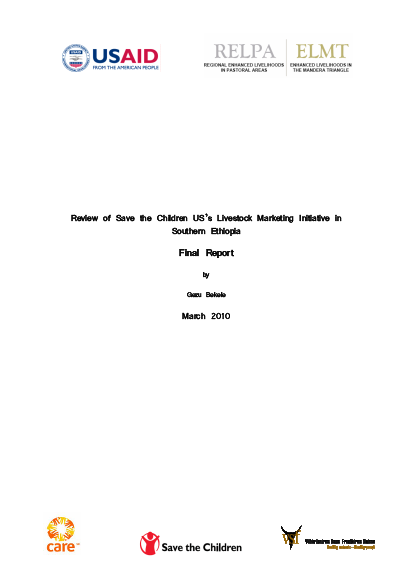
This report presents the findings of a participatory impact assessment of the LMGs operating in Liben, Gorodola and Arero woredas in Oromia Region and Moyale woreda in Somali Region. The assessment was carried out roughly sixteen months after the LMGs had started operating. The assessment described in this report had two key objectives, first to collect evidence on specific impact of the 2006 and 2008 droughts on livestock resources and market prices and second to measure the impact of the LMG activity on livestock marketing off-take. The establishment of LMGs has gone smoothly, and the results indicate that the groups have helped people cope with livestock losses associated with rain-failure in the year 2008. Seven out of the ten LMGs assessed had been involved into the implementation of small scale de-stocking and restocking programs designed by Save the Children US in response to the drought of 2008. The LMGs displayed commitment and efficiency in this work. For example, the LMGs were able to destock around 300 breeding cows (hawicha) at the emergency stage and, purchase 40 breeding camels and 300 small ruminants to restock drought affected households. The livestock marketing groups helped reduce the overhead costs of livestock emergency programs. The LMGs also provide opportunities for members to borrow – take credit – which is important in communities which lack formal microfinance services. As a result they have helped poor members of their community cope with emergency health and social problems. The loans were used to purchase food, invest in education, and to cover medical expenses such delivery problems referred to hospital. LMGs have also expanded their work to include non-livestock marketing activities eg petty trade. However, the results indicate that the LMGs alone are unlikely to have a significant impact on livestock marketing problems of their community at drought times. The main reason for this is that the drought- affected livestock population purchased by LMGs is too few to facilitate the level of destockin required. The study findings indicate that LMGs would require access to larger loans for this. It is important that LMGs are linked to large scale traders and exporters, feedlots and abattoirs. One way of doing this might be to help groups hire trucks for the first few supply rounds. This would build on the familiarization visits that Save the Children organised for members to visit Nazareth and Modjo feedlots. Unfortunately, links with one trader failed as the Group did buy the cattle as agreed, but the trader then refused to take the animals. Livestock marketing in Ethiopia will continue to face challenges - shortage of capital, lack of livestock feed, inadequate animal health and lack of reliable livestock markets remain a major challenge. This makes the work of LMGs challenging.